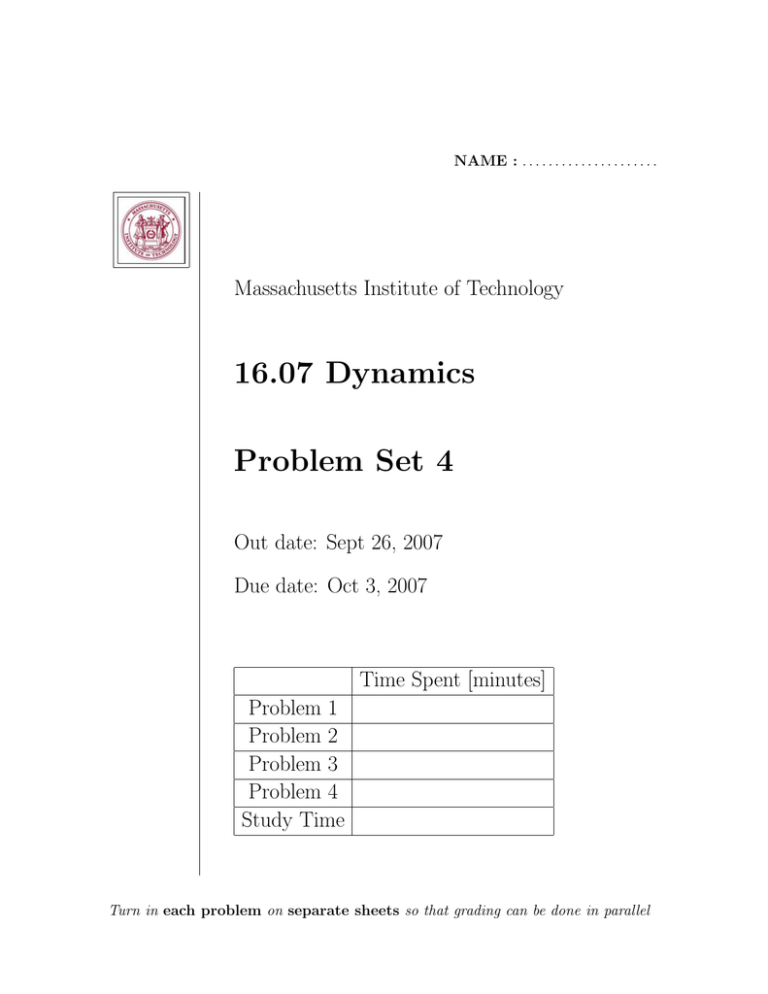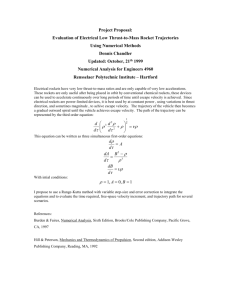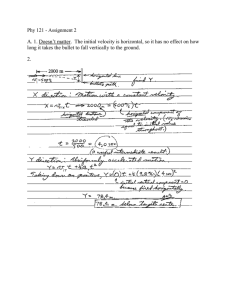Document 13352607
advertisement

NAME : . . . . . . . . . . . . . . . . . . . . . Massachusetts Institute of Technology 16.07 Dynamics Problem Set 4 Out date: Sept 26, 2007 Due date: Oct 3, 2007 Time Spent [minutes] Problem 1 Problem 2 Problem 3 Problem 4 Study Time Turn in each problem on separate sheets so that grading can be done in parallel Problem 1 (10 points) An out of control rocket traces an upward helical trajectory described in cartesian coordinates for t > 0 by x = R cos(ωt) y = R sin(ωt) z = v0 t • A Express the position, velocity and acceleration vectors in the cartesian x, y, z system using unit vectors i, j, k as sketched. • B Express the position, velocity and acceleration vectors in the cylindrical coor­ dinate system using unit vectors er , eθ and k as sketched. • C Express the velocity and acceleration vectors using intrinsic coordinates and the unit vectors unit vectors et , en and eb as sketched. • D Where is the center of curvature for this curve when the particle is located at x = 0, y = R ? Problem 2 (10 points) Part A A toy car enters a frictionless elliptical racetrack aligned vertically after being dropped down a frictionless guided slot from a height h0 under the influence of gravity. We wish to use intrinsic coordinates to describe its velocity and its acceleration and predict the normal force that it exerts on the track as a function of its position. We describe the ellipse by the parametric equation r(q) = aCos(q)i + bSin(q)j (1) where i and j are the unit vectors in the x and y directions. The parameter q is not the angle θ but is closely related to it. q will give us a unique one-parameter description of this problem. A.) From the given information, find the scaler velocity vt (q) along the track as a function of the parameter q. B.) Find the radius of curvature as a function of q. C.) Find the component of acceleration normal to the track as a function of q. D.) Does the car always stay in contact with the track? Where is it likely to depart from contact? What value of h0 is required at the initial drop of the car to ensure that the car always remains in contact with the track at this critical point? What criterion did you apply to ensure that the car stays in contact with the track? E.) What is the relationship between q and θ? Where are they equal? Problem 3 (5 points) A. Consider the spring-mass system shown. The mass m rides on a rod fixed to a platform so that there is no motion in y. The spring is of length L0 with spring constant k. For an initial velocity V0 as shown, and an initial equilibrium position of the spring x(0) = 0, find the response x(t). B. Now, consider that the spring-mass configuration is fixed to a turntable which is rotating with constant angular velocity Ω about the z axis through the point O, and so are you! Write the equation governing the motion of the spring mass in this coordinate system. Repeat the problem with the same initial conditions: x(0) = 0, and the initial velocity V0 . (Take x(0) as the initial equilibrium position of the spring on the rotating table; this will differ slightly from the equilibrium position x(0) of part A.) What is the response x(t)? Interpret your answer. Is the system stable for all values of Ω? Why or why not? Problem 4 (15 points) MATLAB Problem Part A Case 1. Two astronauts are located on the space station which rotates about the z axis through the point O with ω = .1rad/sec. Astronaut 1 is located a distance 10 m. from the center of rotation; astronaut 2 is located along the same line from the point O and at a distance of 20m. Astronaut 1 desires to toss a cheeseburger to astronaut 2 as sketched in the figure. The magnitude of the velocity of launch is V0 = .86m/s. The angle of launch is θ. Determine θ so that the cheeseburger reaches astronaut 2. Take the ballistic coefficient of the cheeseburger as 0. Assume the astronaut can reach out and grab the cheeseburger so don’t try to get your accuracy below .2 m. Use the notation θ1i to denote the initial θ for Case 1. To determine θ1i , set up the governing differential equations for x(t) and y(t) in a rotating coordinate system. Run trajectory calculations, plotting y(t) vs. x(t) to visualize the trajectory. Vary θ1i until the cheeseburger reaches the astronaut. Run your calculations to determine θ1i to the nearest degree. For later use, determine the final velocity vector V1f and final trajectory angle θ1f . We will use the notation θ1i to denote the initial angle of this first trajectory Case 1; the notation θ1f to denote the final angle of this first trajectory; the notation V1i to denote the initial velocity vector for Case 1; the notation V1f , the final velocity for Case 1. There are two solutions for this problem: one has θ1i less than 90o ; one has θ1i greater than 90o . You may study both if you wish but present the results for θ1i > 90o . What is the flight time, Tf ? Part B Astronaut 2 desires to return the cheeseburger to astronaut 1. The first question is: can he send it back along the same trajectory , by starting at point 2 and simply reversing the velocity vector obtained in Part A, and using this as the initial velocity for case 2: that is V2i (0) = −V1f (Tf ) ? Case 2: run your calculations with initial conditions given by the final conditions of Case 1 with the velocity reversed: the initial position vector is x2i (0) = x1f (t), the initial velocity vector is V2i (0) = −V1f (Tf ). What happens? Does the cheeseburger retrace the original trajectory? Does astronaut 1 get her cheeseburger back? Case 3. (entering the twilight zone) A very important property of orbits comes from a remarkable result known as the image theorem, which states that in general a trajectory cannot be flown in reverse back to its original point, but that we can fly its image, as sketched in the figure. (The definition of the image trajectory is the trajectory reflected about a line from the origin to the beginning of the image flight.) That is we can start from point 2, and fly the image trajectory by reversing the initial condition on the x velocity leaving the y velocity unchanged, as sketched. The importance of this profound result is that while we cannot get back to earth from the moon by flying back along our original trajectory, we can fly back on the image trajectory, whew!!!! Run your calculations with initial conditions for Case 3 given by the final conditions of Case 1 but switched to fly the image trajectory: the initial position is x3i (0) = x1f (Tf ), the initial components of velocity are u3i (0) = −u1f (Tf ) and v3i (0) = v1f (Tf ), i.e. the x velocity u is reversed. Does astronaut 1 get her cheeseburger back? Deliverables: Part A Case 1 submit a plot of the final trajectory as well as the value of θ1i and time of flight Tf . Part B Case 2 submit a plot of the ”reversed” trajectory. Part B Case 3 Submit a plot of the flight along the image trajectory. Verify that the final velocity in Case 3 is the ”image” of the initial velocity in Case 1 and that the time of flight Tf is the same.. MIT OpenCourseWare http://ocw.mit.edu 16.07 Dynamics Fall 2009 For information about citing these materials or our Terms of Use, visit: http://ocw.mit.edu/terms.


